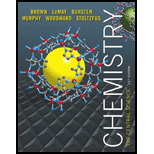
Chemistry: The Central Science (13th Edition)
13th Edition
ISBN: 9780321910417
Author: Theodore E. Brown, H. Eugene LeMay, Bruce E. Bursten, Catherine Murphy, Patrick Woodward, Matthew E. Stoltzfus
Publisher: PEARSON
expand_more
expand_more
format_list_bulleted
Textbook Question
Chapter 20, Problem 88E
A plumber’s handbook states that you should not connect a copper pipe directly to a steel pipe because
Expert Solution & Answer
Want to see the full answer?
Check out a sample textbook solution
Chapter 20 Solutions
Chemistry: The Central Science (13th Edition)
Ch. 20.1 - What is the reducing agent in the following...Ch. 20.1 - Prob. 20.1.2PECh. 20.2 - Prob. 20.2.1PECh. 20.2 - Prob. 20.2.2PECh. 20.2 - Prob. 20.3.1PECh. 20.2 - Prob. 20.3.2PECh. 20.3 - 12.11 Covalent bonding occurs in both molecular...Ch. 20.3 - Prob. 20.4.2PECh. 20.4 - 12.13 What kinds of attractive forces exist...Ch. 20.4 - Prob. 20.5.2PE
Ch. 20.4 - Prob. 20.6.1PECh. 20.4 - Prob. 20.6.2PECh. 20.4 - Prob. 20.7.1PECh. 20.4 - Prob. 20.7.2PECh. 20.4 - Prob. 20.8.1PECh. 20.4 - Amorphous silica, SiO2, has a density of about...Ch. 20.5 - Two patterns of packing for two different circles...Ch. 20.5 - Prob. 20.9.2PECh. 20.5 - Prob. 20.10.1PECh. 20.5 - Prob. 20.10.2PECh. 20.6 - Prob. 20.11.1PECh. 20.6 - Prob. 20.11.2PECh. 20.6 - Prob. 20.12.1PECh. 20.6 - Prob. 20.12.2PECh. 20.6 - Prob. 20.13.1PECh. 20.6 - Prob. 20.13.2PECh. 20.9 - Prob. 20.14.1PECh. 20.9 - Prob. 20.14.2PECh. 20 - 12.53 Which would you expect to be the more...Ch. 20 - 12.54 Which of the following statements does not...Ch. 20 - Prob. 2ECh. 20 - Prob. 3ECh. 20 - Prob. 4ECh. 20 - Prob. 5ECh. 20 - Prob. 6ECh. 20 - Prob. 7ECh. 20 - Prob. 8ECh. 20 - Prob. 9ECh. 20 - Prob. 10ECh. 20 - Prob. 11ECh. 20 - Prob. 12ECh. 20 - Prob. 13ECh. 20 - Prob. 14ECh. 20 - Prob. 15ECh. 20 - Prob. 16ECh. 20 - Prob. 17ECh. 20 - Prob. 18ECh. 20 - Prob. 19ECh. 20 - Prob. 20ECh. 20 - Prob. 21ECh. 20 - Prob. 22ECh. 20 - Prob. 23ECh. 20 - Prob. 24ECh. 20 - Prob. 25ECh. 20 - 12.61 A particular form of cinnabar (HgS) adopts...Ch. 20 - Prob. 27ECh. 20 - Prob. 28ECh. 20 - Prob. 29ECh. 20 - Prob. 30ECh. 20 - (a) What does the term electromotive force mean?...Ch. 20 - Prob. 32ECh. 20 - Prob. 33ECh. 20 - Prob. 34ECh. 20 - Prob. 35ECh. 20 - Prob. 36ECh. 20 - Prob. 37ECh. 20 - Prob. 38ECh. 20 - Prob. 39ECh. 20 - Prob. 40ECh. 20 - Prob. 41ECh. 20 - Prob. 42ECh. 20 - Prob. 43ECh. 20 - Prob. 44ECh. 20 - Prob. 45ECh. 20 - Prob. 46ECh. 20 - Prob. 47ECh. 20 - Prob. 48ECh. 20 - 12.86 Write a balanced chemical equation for the...Ch. 20 - Prob. 50ECh. 20 - Prob. 51ECh. 20 - Prob. 52ECh. 20 - Prob. 53ECh. 20 - Prob. 54ECh. 20 - Prob. 55ECh. 20 - Prob. 56ECh. 20 - Explain why “bands” may not be the most accurate...Ch. 20 - Prob. 58ECh. 20 - Prob. 59ECh. 20 - Prob. 60ECh. 20 - An ideal quantum dot for use in TVs does not...Ch. 20 - Prob. 62ECh. 20 - Prob. 63ECh. 20 - Prob. 64ECh. 20 - Prob. 65ECh. 20 - Prob. 66ECh. 20 - Pure iron crystallizes in a body-centered cubic...Ch. 20 - Prob. 68ECh. 20 - Prob. 69ECh. 20 - What type of latticeprimitive cubic, body-centered...Ch. 20 - Prob. 71ECh. 20 - Prob. 72ECh. 20 - Prob. 73ECh. 20 - Energy bands are considered continuous due to the...Ch. 20 - Prob. 75ECh. 20 - Prob. 76ECh. 20 - Prob. 77ECh. 20 - Prob. 78ECh. 20 - Prob. 79ECh. 20 - Prob. 80ECh. 20 - Prob. 81ECh. 20 - Prob. 82ECh. 20 - The karat scale used to describe gold alloys is...Ch. 20 - 12.125 Spinel is a mineral that contains 37.9% AI,...Ch. 20 - Prob. 85ECh. 20 - Prob. 86ECh. 20 - Prob. 87ECh. 20 - A plumber’s handbook states that you should not...Ch. 20 - Silicon has the diamond structure with a unit cell...Ch. 20 - Prob. 90ECh. 20 - Prob. 91ECh. 20 - Prob. 92ECh. 20 - Prob. 93ECh. 20 - Prob. 94ECh. 20 - Prob. 95ECh. 20 - Prob. 96ECh. 20 - Prob. 97AECh. 20 - Prob. 98AECh. 20 - Prob. 99AECh. 20 - Prob. 100AECh. 20 - Prob. 101AECh. 20 - Which of the three-dimensional primitive lattices...Ch. 20 - Prob. 103AECh. 20 - 12.27 What is the minimum number of atoms that...Ch. 20 - 12.28 What is the minimum number of atoms that...Ch. 20 - Prob. 106AECh. 20 - Prob. 107AECh. 20 - Prob. 108AECh. 20 - Prob. 109AECh. 20 - Prob. 110AECh. 20 - Prob. 111IECh. 20 - Prob. 112IECh. 20 - Prob. 113IECh. 20 - Prob. 114IECh. 20 - Prob. 115IECh. 20 - Prob. 116IECh. 20 - Prob. 117IECh. 20 - Prob. 118IECh. 20 - Prob. 119IE
Knowledge Booster
Learn more about
Need a deep-dive on the concept behind this application? Look no further. Learn more about this topic, chemistry and related others by exploring similar questions and additional content below.Similar questions
- The mass of three different metal electrodes, each from a different galvanic cell, were determined before and after the current generated by the oxidation-reduction reaction in each cell was allowed to flow for a few minutes. The first metal electrode, given the label A, was found to have increased in mass; the second metal electrode, given the label B, did not change in mass; and the third metal electrode, given the label C, was found to have lost mass. Make an educated guess as to which electrodes were active and which were inert electrodes, and which were anode(s) and which were the cathode(s).arrow_forwardGalvanized steel pipes are used in the plumbing of many older homes. When copper plumbing is added to a system consisting of galvanized steel pipes it is necessary to place an insulator between the copper and the steel to avoid corrosion. Write a balanced oxidation-reduction equation for the reaction that occurs if the pipes are directly connected. What is the standard potential between the metals?arrow_forwardA magnesium bar with a mass of 6.0 kg is attached to a buried iron pipe to serve as a sacrificial anode. An average current of 0.020 A flows between the bar and the pipe. (a) What reaction takes place at the surface of the magnesium bar? (b) What reaction takes place at the surface of the iron pipe? (C) In which direction do electrons flow between the two surfaces? (d) How many years would it take for the entire magnesium bar to be consumed?arrow_forward
Recommended textbooks for you
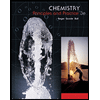 Chemistry: Principles and PracticeChemistryISBN:9780534420123Author:Daniel L. Reger, Scott R. Goode, David W. Ball, Edward MercerPublisher:Cengage Learning
Chemistry: Principles and PracticeChemistryISBN:9780534420123Author:Daniel L. Reger, Scott R. Goode, David W. Ball, Edward MercerPublisher:Cengage Learning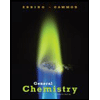 General Chemistry - Standalone book (MindTap Cour...ChemistryISBN:9781305580343Author:Steven D. Gammon, Ebbing, Darrell Ebbing, Steven D., Darrell; Gammon, Darrell Ebbing; Steven D. Gammon, Darrell D.; Gammon, Ebbing; Steven D. Gammon; DarrellPublisher:Cengage LearningChemistry: Matter and ChangeChemistryISBN:9780078746376Author:Dinah Zike, Laurel Dingrando, Nicholas Hainen, Cheryl WistromPublisher:Glencoe/McGraw-Hill School Pub Co
General Chemistry - Standalone book (MindTap Cour...ChemistryISBN:9781305580343Author:Steven D. Gammon, Ebbing, Darrell Ebbing, Steven D., Darrell; Gammon, Darrell Ebbing; Steven D. Gammon, Darrell D.; Gammon, Ebbing; Steven D. Gammon; DarrellPublisher:Cengage LearningChemistry: Matter and ChangeChemistryISBN:9780078746376Author:Dinah Zike, Laurel Dingrando, Nicholas Hainen, Cheryl WistromPublisher:Glencoe/McGraw-Hill School Pub Co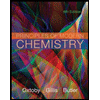 Principles of Modern ChemistryChemistryISBN:9781305079113Author:David W. Oxtoby, H. Pat Gillis, Laurie J. ButlerPublisher:Cengage Learning
Principles of Modern ChemistryChemistryISBN:9781305079113Author:David W. Oxtoby, H. Pat Gillis, Laurie J. ButlerPublisher:Cengage Learning Chemistry by OpenStax (2015-05-04)ChemistryISBN:9781938168390Author:Klaus Theopold, Richard H Langley, Paul Flowers, William R. Robinson, Mark BlaserPublisher:OpenStax
Chemistry by OpenStax (2015-05-04)ChemistryISBN:9781938168390Author:Klaus Theopold, Richard H Langley, Paul Flowers, William R. Robinson, Mark BlaserPublisher:OpenStax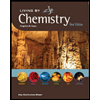 Living By Chemistry: First Edition TextbookChemistryISBN:9781559539418Author:Angelica StacyPublisher:MAC HIGHER
Living By Chemistry: First Edition TextbookChemistryISBN:9781559539418Author:Angelica StacyPublisher:MAC HIGHER

Chemistry: Principles and Practice
Chemistry
ISBN:9780534420123
Author:Daniel L. Reger, Scott R. Goode, David W. Ball, Edward Mercer
Publisher:Cengage Learning

General Chemistry - Standalone book (MindTap Cour...
Chemistry
ISBN:9781305580343
Author:Steven D. Gammon, Ebbing, Darrell Ebbing, Steven D., Darrell; Gammon, Darrell Ebbing; Steven D. Gammon, Darrell D.; Gammon, Ebbing; Steven D. Gammon; Darrell
Publisher:Cengage Learning

Chemistry: Matter and Change
Chemistry
ISBN:9780078746376
Author:Dinah Zike, Laurel Dingrando, Nicholas Hainen, Cheryl Wistrom
Publisher:Glencoe/McGraw-Hill School Pub Co

Principles of Modern Chemistry
Chemistry
ISBN:9781305079113
Author:David W. Oxtoby, H. Pat Gillis, Laurie J. Butler
Publisher:Cengage Learning

Chemistry by OpenStax (2015-05-04)
Chemistry
ISBN:9781938168390
Author:Klaus Theopold, Richard H Langley, Paul Flowers, William R. Robinson, Mark Blaser
Publisher:OpenStax

Living By Chemistry: First Edition Textbook
Chemistry
ISBN:9781559539418
Author:Angelica Stacy
Publisher:MAC HIGHER
Introduction to Electrochemistry; Author: Tyler DeWitt;https://www.youtube.com/watch?v=teTkvUtW4SA;License: Standard YouTube License, CC-BY